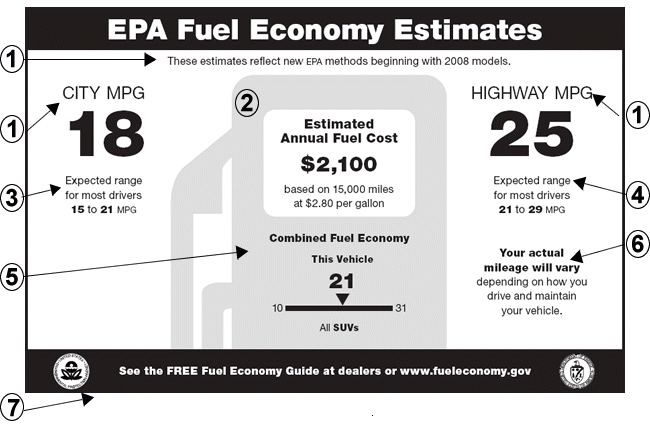Model Year 2008-2012 Fuel Economy Label
In December 2006, EPA issued updated test methods to determine the fuel economy estimates (city and highway) that appear on the window stickers of all new cars and light trucks sold in the U.S., beginning with 2008 models. For more information about the updated methods, see EPA's Final Rule.
This page describes the revised fuel economy label that was introduced in September 2008 and provides the basic fuel economy estimates. For comparison, you can see the previous fuel economy label for cars and light trucks sold before model year 2008.

The improved features of the label are listed below:
1. Updated Methods: The label shows the estimated city MPG at the top left, and highway MPG at the top right. The estimates on 2008 and later models are determined using new, more realistic methods. During the transition year, comparison shoppers should compare models that are built in the same model year, so compare 2007 models to 2007 models, etc.
2. Estimated Annual Fuel Costs: The center of the label provides estimated annual fuel costs based on a given number of miles and fuel price, also listed on the label. Use this information to estimate fuel costs for this vehicle, and to compare fuel costs across different models.
3. Expected City Range: Estimated city MPG range appears at the top left, under the main city MPG estimated number. Most drivers can expect to achieve city fuel economy within this range.
4. Expected Highway Range: Estimated highway MPG range appears at the top right, under the main highway MPG estimated number. Most drivers can expect to achieve highway fuel economy within this range.
5. Compare to Other Vehicles: The lower center of the label gives a combined city/highway estimate for that vehicle, and shows where that value falls on a bar scale that gives the highest and lowest fuel economy of all other vehicles in its class (e.g. SUVs, minivans, compact cars, etc). Use this information to compare the fuel economy of this vehicle to all others within its class.
6. Your actual mileage will vary: The label includes a reminder that there are many reasons why your actual fuel economy may vary from the estimates. See www.fueleconomy.gov for fuel-saving tips.
7. For more information: The label provides a Web address where you can find out more information. See the FREE Fuel Economy Guide at dealers or online at www.fueleconomy.gov.
